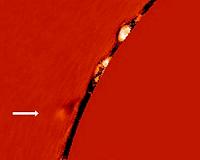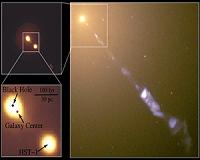|
 Bursting 'Bubbles' - The Origin Of Galactic Gas Clouds
Bursting 'Bubbles' - The Origin Of Galactic Gas CloudsCanberra, Australia (SPX) Jun 01, 2010 Like bubbles bursting on the surface of a glass of champagne, 'bubbles' in our Galaxy burst and leave flecks of material in the form of clouds of hydrogen gas, researchers using CSIRO's Parkes telescope have found. Their study explains the origin of these clouds for the first time. Swinburne University PhD student Alyson Ford (now at the University of Michigan) and her supervisors; Dr Naomi McClure-Griffiths (CSIRO Astronomy and Space Science) and Felix Lockman (US National Radio Astronomy O ... read more |
. |
|
|
Free Space, Earth, Energy And Military Newsletters - Delivered Daily |
| . | . |
| .. |
Weird Orbits Of Neighbors Can Make 'Habitable' Planets Not So Habitable Seattle WA (SPX) May 27, 2010
Seattle WA (SPX) May 27, 2010Astronomers hunting for planets orbiting nearby stars similar to the sun are looking for signs of rocky, Earth-like planets in a "habitable" zone, where conditions such as temperature and liquid water remain stable enough to support life. New findings from computer modeling indicate that some of those exoplanets might fluctuate between being habitable and being inhospitable to life because ... more Swift Survey Finds Smoking Gun Of Black Hole Activation  Greenbelt MD (SPX) May 27, 2010
Greenbelt MD (SPX) May 27, 2010Data from an ongoing survey by NASA's Swift satellite have helped astronomers solve a decades-long mystery about why a small percentage of black holes emit vast amounts of energy. Only about one percent of supermassive black holes exhibit this behavior. The new findings confirm that black holes "light up" when galaxies collide, and the data may offer insight into the future behavior of the ... more Caterpillar Participates In Inaugural Lunabotics Mining Competition  Cape Camaveral FL (SPX) May 27, 2010
Cape Camaveral FL (SPX) May 27, 2010To showcase its world-class technology leadership, Caterpillar is supporting the NASA Lunabotics Mining Competition at the Kennedy Space Center, Cape Canaveral, Florida. The event, May 27-28, 2010, is designed to engage and retain college students in the areas of science, technology, engineering and mathematics (STEM). "The students at the competition are the Caterpillar engineers of tomor ... more |
.. |
 STEREO, SOHO Spacecraft Catch Comet Diving Into Sun  Supermassive Black Holes May Frequently Roam Galaxy Centers  Instant online solar energy quotes Solar Energy Solutions from ABC Solar |
.. |
|
|
Free Space, Earth, Energy And Military Newsletters - Delivered Daily |
|
|
. |
 Get It While it's Hot! Star Devours Planet
Get It While it's Hot! Star Devours PlanetMoffett Field CA (SPX) May 26, 2010 The hottest known planet in the Milky Way galaxy may also be its shortest-lived world. The doomed planet is being eaten by its parent star, according to observations made by a new instrument on NASA's Hubble Space Telescope, the Cosmic Origins Spectrograph (COS). The planet may only have another 10,000 years left before it is completely devoured. The planet, called WASP-12b, is so close to its sunlike star that it is superheated to nearly 2,800 degrees Fahrenheit and stretched into a football shap ... read more |
| The contents herein, unless otherwise known to be public domain, are Copyright 1995-2010 - SpaceDaily. AFP and UPI Wire Stories are copyright Agence France-Presse and United Press International. ESA Portal Reports are copyright European Space Agency. All NASA sourced material is public domain. Additional copyrights may apply in whole or part to other bona fide parties. Advertising does not imply endorsement, agreement or approval of any opinions, statements or information provided by SpaceDaily on any web page published or hosted by SpaceDaily. Privacy statement |
| Previous Issues | May 31 | May 28 | May 27 | May 26 | May 25 |